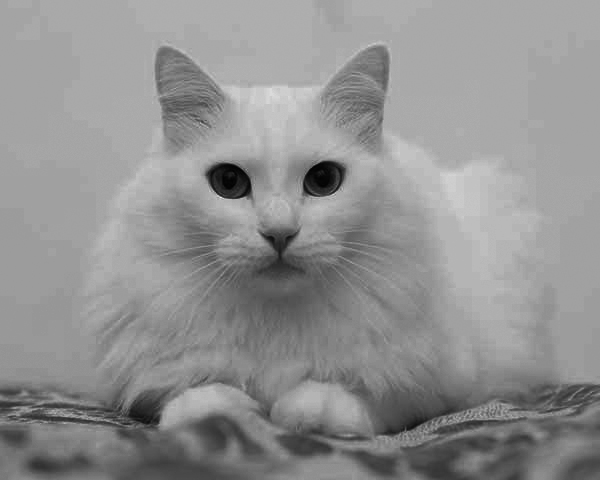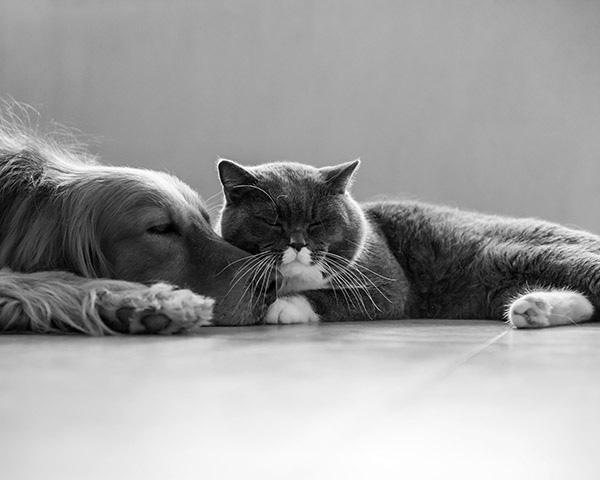Turkish Angora cat breed information and advice
The Turkish Angora originated in the 15th century Ankara region of Turkey, formerly known as Angora. Its ancestry also lends to their original name, the Ankara cat.
Angora cats are considered a national treasure in Turkey and these beautiful cats are a rare find in the UK. Known for being intelligent, energetic and affectionate, they make entertaining family pets.
Turkish Angora cat facts

| Lifespan | 15 – 20 years |
| How much | £100 – £650 |
| Size | 36 – 41 cm |
| Weight | 3-5 kg – 5 kg |
| Colours | White, black, blue, silver, red, calico, tortoiseshell, silver |
| Grooming | Weekly brush required |
| Temperament | Intelligent, outgoing, affectionate |
| Exercise | High |
Pet insurance for your Turkish Angora cat
The Turkish Angora is generally a healthy cat breed, but it’s always a wise to take out cat insurance should any illness or injuries occur. Cat insurance can help with the cost of any treatment that your pet may need, including dental treatment.
These common health conditions can affect Turkish Angora cats, including:
- Hypertrophic cardiomyopathy (HCM)
- Hereditary deafness
- Hereditary ataxia
- Chronic kidney disease (CKD)
With health issues occurring in cats at any age, it’s worth taking out pet insurance when your Angora cat is a kitten.
Sainsbury’s Bank Pet Insurance
Sainsbury's Bank Pet Insurance is available for Turkish Angora cats from eight weeks of age. Injuries are covered after three days of the policy being taken out and illnesses are covered from 14 days.
There are three types of pet insurance policies to choose from depending on your cat’s needs:
- Lifetime – covers your cat for ongoing issues and total vet costs of up to £10,000 a year.
- Maximum benefit – lets you claim the same condition multiple times and covers vet bills up to £6,000.
- Time limited – cover vet costs for your Angora cat’s short-term health issues of up to £3,000, or for 12 months.
If you have multiple four-legged family members, why not take out multi-pet insurance? More protection, more savings.
Please note, we won't cover any pre-existing conditions. Terms, conditions, excesses, exclusions and limitations apply.
How to care for a Turkish Angora cat
Despite their semi-long, luxurious fur, Turkish Angoras are easy to maintain. They’re very sociable and love attention, so you can expect constant company.
Like all cats, Angoras need a balanced, nutritious diet and lots of exercise to keep them in good condition. To keep your cat happy, healthy and at their best, here’s some care tips to look after your Turkish Angora.
Feeding and nutrition
When you bring your new Turkish Angora kitten home it’s recommended to follow the feeding routine set out by the breeder.
If you want to change your Angora cat’s diet, you’ll need to do it gradually. Ask your vet to recommend a replacement cat food that best fits the needs of your Turkish Angora. They’ll be able to tell you how much to feed to keep them at a healthy weight.
Grooming
Despite being semi-longhaired, Turkish Angoras are fairly low maintenance. They’re single-coated with long, silky fur, which makes their coats easier to care for.
They will only need grooming with a comb or brush once or twice a week. They may need an occasional bath, especially if white or light-coloured. Fortunately, Turkish Angoras love playing in water, so this should take care of washing their coat. You should also brush their teeth with vet-approved toothpaste, checking for any gum disease at the same time.
Exercise
Turkish Angoras are energetic and enjoy being up high, so they can be found on top of bookcases or open doors. You could provide them with a cat tree or perch to scratch their itch of climbing.
Providing your Angora cat with interactive toys to play with can keep them from becoming bored and getting up to mischief. You should also devote time to play with them – at least 15 to 30 minutes a day. This not only maintains their kitten-like energy, but it’s also a great opportunity to bond.
Training
An intelligent breed, Turkish Angoras enjoy human interaction which means they can be easily trained. They’ll quickly pick up toilet or litter training, especially if they’re rewarded with treats. Angora cats also enjoy being taught new tricks such as playing ‘fetch’ or walking on a lead.
Thanks to their endless energy and curiosity, they should be kept indoors. This can help to prevent straying or theft.
Temperament and behaviour
Turkish Angoras like to be the boss of the household, they can be vocal and have alpha tendencies to be the dominant pet. Be wary when introducing a Turkish Angora into a house that already has pets. They’re curious and probably too active to relax on your lap for too long. They’ll be interested in whatever you’re doing and aren’t shy so you can expect them to be forward with visitors.
If allowed outside, make sure the space is enclosed and secure to keep them safe. Beware, they also have a strong hunting instinct so they can be good mousers and leave unexpected presents for you.
Common health problems
Turkish Angoras are generally healthy but hypertrophic cardiomyopathy and deafness can occur in the breed. They can also be affected by a condition called Turkish Angora Ataxia. Regular health checks will help identify any potential problems. Common health issues, as well as any breed-related diseases, can be covered by cat insurance.
Hypertrophic cardiomyopathy (HCM)
Hypertrophic cardiomyopathy (or HCM) is a disease that thickens the heart muscle and reduces the amount of blood flowing through the heart. HCM is likely inherited in certain cat breeds, including the Turkish Angora. Fortunately, a genetic test is available, and screening of cats using echocardiography (a scan of the heart using ultrasound) is recommended. If the condition is recognised early enough, long-term medication and other measures can slow the disease down.
Hereditary deafness
Deafness can affect pure white, blue-eyed or odd-eyed Angora cats. But, they are no more prone to becoming deaf than any other pure white cat. Deaf cats can lead normal lives, especially if they’re kept indoors. Contact your vet if your cat doesn’t respond to verbal cues.
Hereditary ataxia
Ataxia is an incoordination in the nervous system inherited in Turkish Angora cats. There are different types of ataxia which can stem from various conditions and causes. Signs of ataxia include stumbling, lack of coordination, head tilting and the inability to stand. Treatment depends on the underlying cause, but antibiotics and surgery are available.
Chronic kidney disease (CKD)
CKD is the common kidney disease in cats that causes the kidneys to lose function over time. It’s found in certain breeds, including Turkish Angoras. Cats with CKD can experience lethargy, weight loss and the lose the ability to urinate properly. While there is no cure, CKD can be managed with diet change, antibiotics and supplements.
So, is a Turkish Angora cat right for you?
Turkish Angoras love attention and will fit in well with busy, active families, especially those with older children. They’re energetic, intelligent, and enjoy playing with their owners. They’ll get along with other cats and cat-friendly dogs, but they’ll want to be boss. Turkish Angoras may not cope well if left alone too long and if everyone is out at work all day, consider getting another cat or dog, albeit a submissive one, to keep them company.
Frequently asked questions
Are Turkish Angora cats rare?
Yes, although one of the world’s oldest natural cat breeds, the Turkish Angora is uncommon in the UK. The breed isn’t recognised in this country, although it is by most other international breed clubs. If you want to buy an Angora cat from a reputable breeder in the UK, there is likely to be a waiting list.
How to identify a Turkish Angora cat?
A typical Turkish Angora has a semi-long, silky coat and is fine boned yet muscular. It has a wedge-shaped head, tall, pointed ears, large, almond-shaped eyes and a long, fine and full tail. White is the most common colour, but many other colours can be seen, including black.
Do Turkish Angora cats like to be held?
Not especially, Turkish Angora cats prefer to be on the go as they’re quite active. But, don’t let this put you off, they are still very affectionate.
Browse our guides

Choose from our list of helpful guides and information
Explore dog breeds

Find out how to keep your dog healthy and happy
Cat breed guides

How to care for your cat, common health problems and more
Terms and conditions
Important information
Sainsbury's Bank plc, Registered Office, 33 Charterhouse Street, London, EC1M 6HA (registered in England and Wales, no 3279730) is authorised by the Prudential Regulation Authority and regulated by the Financial Conduct Authority and the Prudential Regulation Authority (register no. 184514).
Sainsbury's Supermarkets Ltd is an appointed representative of Sainsbury's Bank plc. Sainsbury's Bank plc acts as an introducer to Pinnacle Insurance Ltd who is authorised by the Prudential Regulation Authority and regulated by the Financial Conduct Authority and the Prudential Regulation Authority (register number 110866). Registered office: 4th Floor, Limelight, Elstree Way, Borehamwood, Hertfordshire, WD6 1JH. Sainsbury’s Bank Pet Insurance is arranged, administered and underwritten by Pinnacle Insurance Ltd. Sainsbury's Bank plc and Pinnacle Insurance Ltd are not part of the same corporate group.
We do not provide personal recommendations to customers.
